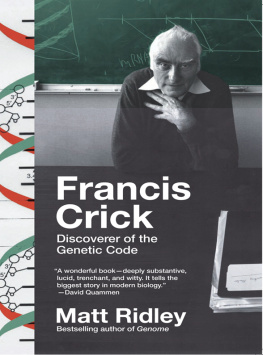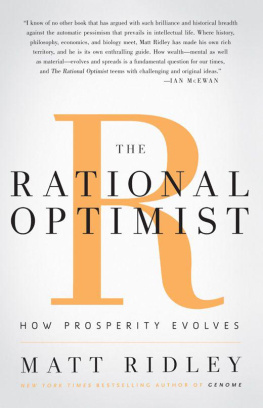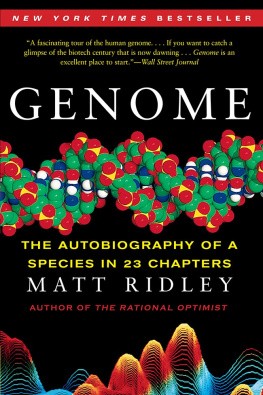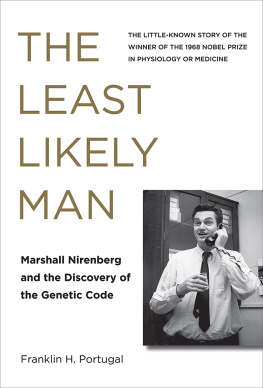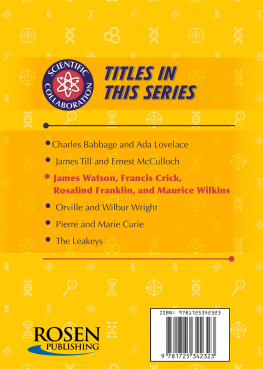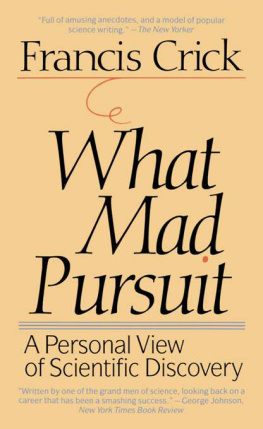F RANCIS C RICK
Discoverer of the Genetic Code
Matt Ridley
EMINENT LIVES

For Felicity
Contents
O N 8 JUNE 1966 THERE was a party on the lawn of Blackford Hall, one of the houses belonging to the famous Cold Spring Harbor Laboratory on the north shore of Long Island. After a lobster banquet, a girl called Fifi, wearing a bikini, burst out of a giant cakenot the usual climax to a scientific conference. But it was not the usual pretext for a party. It was the fiftieth birthday of Francis Crick, a man routinely described by other scientists the cleverest person I have ever met. It was also the actual birthday of Cricks scientific baby, the genetic code. Crick had just put the finishing touches on a little cipher chart, which gave the exact protein translation for all but one of the three-letter words in the lexicon of DNA. That code, he rightly suspected, was universal to all living creaturesproving that all livings things have a single common ancestor. It was, in fact, the reason they were living. It carried messages from the past to the future, messages about how to build living bodies from food by directing the synthesis of proteins. It was the very definition of the difference between living and nonliving, a difference Crick had set out deliberately to define nearly 20 years before.
On that day Crick stood on top of the scientific world. Others had done some of the crucial experiments in the decoding of the code, and others had shared the excitement of vital discoveries along the waythe messenger, the adaptor, the triplet nature of the codebut Crick had been there at every step, the dominant theoretical thinker, the best guesser, the indefatigable sceptic, the loudest debater, the conductor of the scientific orchestra. Thirteen years before, he and James Watson had discovered suddenly and famously that there was a code at all, when they stumbled on the structure of DNA, the stuff from which genes are made. Now, the code was cracked. The reason a rabbit differed from a rock was that it had a long message inside it written in three-letter words in a four-letter alphabet. The reason a rabbit differed from a person was that it had a different sequence of letters in its message. Life was that simple. Crick could cross it off a mental list he had imagined long agoa list of mysteries that must be snatched from the hands of mystics and handed over to reason. It had been a short list, with just two items: life and consciousness. Life was done.
As a small boy Francis Crick had been haunted by a fear that by the time he grew up everything would have been discovered. Inspired by Arthur Mees Childrens Encyclopedia, the boy had become fascinated by the unexpectedness of scientific answers. From a very early age he longed to find some of his own, but would there be anything left? Dont worry, ducky, said his mother. There will be plenty left for you to find out.
F RANCIS HARRY COMPTON CRICK was born on 8 June 1916, at the height of World War I. The day before he was born, the news had broken that Lord Kitchener, Britains celebrated minister of war, had been killed on board a cruiser bound for Russia. When Crick was a few weeks old, the first day of the battle of the Somme would claim 20,000 British lives. Far away from all this death, Crick was born at home in Holmfield Way in Northampton, a middle-class street in a middle-size town in the middle of the English Midlands. He was the son of a shoe manufacturer, Northampton being the shoemaking capital of Britain. Its streets were full of workshops and factories where leather-aproned workers still hammered and stitched soles, heels, and uppers. Shoemaking was an increasingly mechanised trade, thanks partly to the invention of one Thomas Crick of Leicester, who in 1853 took out a patent for an improved method of fixing uppers to soles with tacks or rivets instead of stitches. But, perhaps fortunately for posterity, Thomas Crick was no ancestor of Francis, who consequently was spared the distractions of great wealth.
Cricks Y chromosome had not wandered far in two centuries, or perhaps for much longer. Crick is not an uncommon surname in the Midlands, the village of Crick in Northamptonshire being its probable origin. In 1861 Franciss great-grandfather Charles Crick was a fairly prosperous farmer, employing 20 men and boys on his 231 acres at Pindon End farm near the lace-making village of Hanslope just 10 miles south of Northampton. Charless second son, Walter Drawbridge Crick, born in 1857, took a job as a clerk in the goods department of the London and Northwestern Railway, whose track bisected his fathers farm. He soon switched to working as a travelling salesman for a shoemaker called Smeed and Warren. In 1880, when he was just 22 years old, he joined two others to start his own boot and shoe factory: Latimer, Crick, and Gunn, at Green Street, Northampton. (The churchyard at Hanslope has several Latimers buried in it, as well as some Cricks, so perhaps Latimer was a family friend.) The business thrived and expanded to Madras in India. At one time it also had five shops in London, and later it made military boots for those doomed young men at the Somme. By 1898 William Latimer and Thomas Gunn had retired, leaving Walter Crick the sole owner of the firm. He did well enough to build a substantial stone mansion, Nine Springs Villa, on Billing Road on the eastern side of Northampton. But five years later Walter Crick (at age 47) died of a heart attack, leaving the firm in the hands of his widow, Sarahwho survived him by 31 yearsand two of his four sons, Walter and Harry, who carried on the business until it failed during the Depression.
The original Walters enthusiasm for shoes, lucrative though it was, seems to have come second to his passion for science, and for collectingfossils, books, stamps, coins, porcelain, and furniture. His friends found him energetic and argumentative. Said one, in terms that might later have been applied to the grandson: He was just as fond of springing a new and carefully stored fact into a discussion as he was of trumping a suit the first time round. He was an amateur naturalist of some local repute, who eventually wrote a two-part survey of the Liassic foraminifera of Northamptonshire and had two gastropods named after him. On foot and bicycle, he wandered the lanes of Northamptonshire collecting fossils and turning over rocks to look for snails. It was a tiny mollusc that caused Walter, grandfather of the greatest biologist of the twentieth century, to forge a brief link with the greatest biologist of the nineteenth: Charles Darwin.
It happened thus. On Saturday, 18 February 1882, Walter Crick was out hunting for water beetles (a curious occupation in winter, surely). We know this because later that day he wrote hesitantly to Darwin to report what he had found. I secured a female Dytiscus marginalis, he told the great evolutionist, with a small bivalve [cockle] that I think is Sphaerium corneum very firmly attached to its leg. Darwin replied three days later with a barrage of questions. He wanted to know the length and breadth of the shell, and how much of the leg (which leg?) had been caught; and he suggested a communication to the magazine Nature. To a young railway clerk turned shoemaker with (to judge by his handwriting) only a rudimentary education, this reply must have been a matter for some excitement. Crick replied with not only the answers, but also the beetle and the shell. Both arrived alive, so Darwin put the wretched insect in a bottle with chopped laurel leaves, that it may die an easy and quicker death. He then sent both specimens off to an expert on shells for identification, but the expert was away and the specimens were returned, broken, by a servant. Meanwhile, Crick had returned to the same pond on a Sunday and found a dead frog with a cockle of the same kind attached to its foot. On 6 April, Darwin published a letter in

